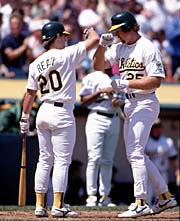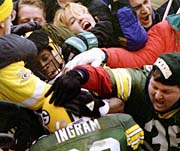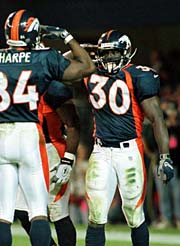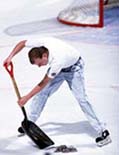Signs and Wonders
A brief history of celebratory sports gestures.
Are they loathsome, or do they attest to the indomitability of the human spirit? They infiltrate every corner of our consciousness, but do we understand them? Let us begin with the act of exuberance that defines the genre:
Raising the Roof: A two-armed, palms-skyward pump. A handstand standing up. The implication: That play was so unbelievable I must raise the roof of this arena to contain the collective excitement I've generated. Paternity remains contested: Some credit Dallas Cowboy Emmitt Smith with the first Roof-Raising, in the 1996 Super Bowl. Others ascribe it to a high-school basketball player in a McDonald's All-America game. Various collegiate teams playing various sports claim ownership. Raising the Roof is the celebratory sports gesture of the moment. Like all inspired sports gestures, it's moved beyond sports. Everybody does it--pro athletes and college athletes, talk-show hosts and talk-show audiences.
But to trace the lineage of Raising the Roof, one must understand the history of the sports gesture itself. One must go back to a time few of us can remember. A time before ...
The High-Five: A gesture so ubiquitous that it's hard to imagine what else people could have done, it wasn't invented until 1980. Its architect was Derek Smith, a forward on the University of Louisville's championship basketball team. When asked why he and teammates had invented this elevated palm slap, Smith replied, "We decided to be a little odd." But how odd can the High-Five seem now? Like the ripped dungaree, the High-Five has swept the nation and been duly coopted. True rebels have been forced to forge new, more exotic gestures.
Thus the '80s saw "the Fun Bunch" (four Washington Redskins receivers) choreographing a leaping High-Five quartet. New York Jets defender Mark Gastineau performed a Twyla Tharpish "Sack Dance" after tackles. Yet, all these lacked the elegant economy of the High-Five. All, that is, until ...

T he Monster Bash: A collision of hard-muscled, pop-veined forearms, which briefly form an "X" upon impact. A barbaric crunching of radius and ulna bones. The Bash began in baseball, and it went everywhere. Its progenitors: Mark McGwire and Jose Canseco, brutish sluggers for the 1988 Oakland A's. After each home run (and there were many), the A's would meet at the plate for Monster Bashing. Within a month of the Bash's invention, the A's marketing department had cooked up a song. The lyrics featured a challenge to the Bash's ancestor: "If you're a big fan of the Oakland A's/ You, too, can do the latest ballpark craze/ When the A's big bats really come alive/ Don't waste time with the boring High-Five."
The Ickey Shuffle: A hulking touchdown jig. Ickey Woods, fullback for the Cincinnati Bengals, debuted this masterpiece in the fall of 1988. The NFL banned celebratory displays, in part as a reaction to the Shuffle, but Ickey would not be repressed--and the fans loved him. So actually ordered Ickey to keep dancing (albeit on the sidelines). Soon, Ickey added a post-Shuffle, hip-rolling "Woo-Woo-Woo" dance, for which Bengals defensive backs joined him. By January 1989, when the Bengals reached the playoffs, what had begun as a struggle for individual expression ended in an avalanche of conformity.
In the '90s, gesture artists sold out. They now seek the public's embrace and are aided by the wildfire spread new gestures enjoy when shown on ESPN's SportsCenter. One need only see ...
The City-Boy Bounce: An arch-backed, fists-clenched shoulder jiggle, sometimes paired with a zombielike trance-walk. Tradition holds it started on playgrounds in New York. Popular mostly with football and basketball players. The Bounce is perhaps the best-looking gesture of all, but it is also the hardest to perform. It requires a level of fluidity not commonly seen in nonathletes. In this sense, the Bounce is a gesture for elitists, and thus a glaring counterpoint to ...

T he Lambeau Leap: A jubilant vault into the stands of Green Bay's Lambeau Field. Invented in 1993: After a big interception, Packers safety Leroy Butler. The populist Leap is particularly suited to the NFL's only publicly owned team, the zealously beloved Pack. Players express their appreciation to the Lambeau fans by hurtling into their midst, for just one moment becoming one of them.
The Leap reached its zenith with the Packers' Super Bowl win last season. This season's hot new gesture?

T he Mile-High Salute: Military tradition turned football celebration. A basic salute to teammates after touchdowns. Creators: the Denver Broncos' running backs, who unveiled the salute at preseason games this summer. A gesture clearly suited to football's warlike nature, the Salute is named for Denver's Mile High Stadium. The Broncos have invited their fans to join in, creating a stadium saluting in unison and marking the pinnacle of the football culture's fascistic tendencies.
The Salute developed into a stadiumwide event, but several other gestures have been designed specifically for a herd of 60,000 sports fans. These include:
The Wave: Generally traced to 1984 and the Seattle Kingdome, though some insist it dates to a 1983 University of Michigan football game. Fans standing at appropriate moments fashion a group undulation. Particularly frustrating for abstainers: A cry of "down in front" will not dampen a rollicking Wave, so sight lines are blocked at regular time intervals. The Wave remains popular, though not as controversial as ...
The Tomahawk Chop: A robotic hacking--only the forearm moves. Often accompanied by an outsized foam tomahawk and a "Native American chant."The Chop gained mass attention when the Atlanta Braves went to the 1991 World Series, but it actually originated with fans of the Florida State Seminoles. Native American groups hate the Chop, but former President Jimmy Carter defended it in 1991: "With the Braves on top, we have a brave, courageous and successful team, and I think we can look on the American Indians as brave, successful and attractive. So I don't look on it as an insult."
Though less controversial, the most bizarre gesture of all remains ...

T he Octopus Toss: In celebratory moments, fans of the Detroit Red Wings throw real octopuses onto the ice. The tradition began in 1952, when teams needed eight playoff victories to win the Stanley Cup. An octopus has eight arms (and smells awful). At times, more than 50 octopuses rain down at once. Another time-honored crowd activity occurs if rink workers refuse to pick up the cephalopods with their bare hands--the crowd boos them.
